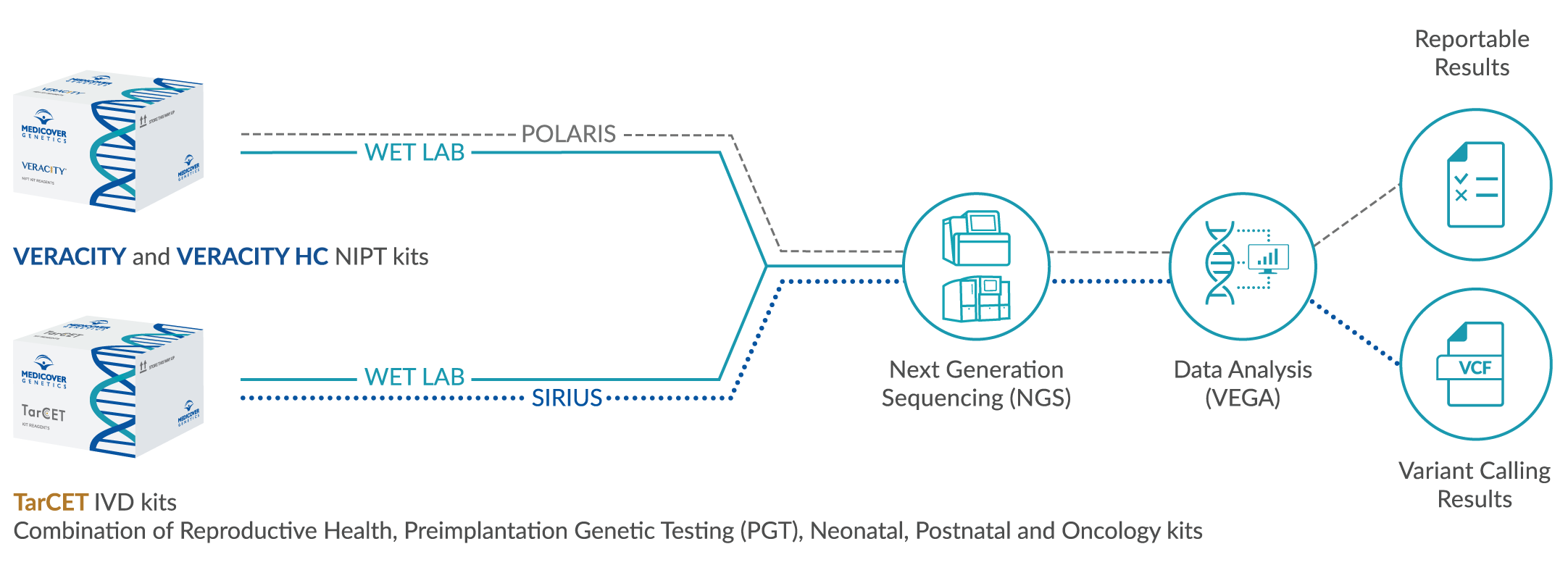Scientific Background
Intellectual disability, defined as an IQ below 70, has a prevalence of 1.5 to 2%. Severe forms with an IQ of <50 have a prevalence of 0.3 to 0.4%. Males are more frequently affected due to X-linked genes. The causes of a reduction in intelligence are manifold; genetic factors, however, are involved in at least 50% of cases. With the examinations that have been possible so far, such as chromosome analysis, array CGH and targeted diagnostics (e.g., fragile X syndrome, Rett syndrome, Angelman syndrome), about 60% of the causes of developmental disorders remain unexplained. Several studies in recent years in which patients with severe intelligence impairment (IQ <50) were examined using new high-throughput sequencing (NGS) could confirm that dominant pathogenic de novo variants appear to contribute to a significant extent to the cause of severe intelligence impairment (e.g., Vissers L. et al, Nat Genet, 2010, de Ligt, J. et al, NEJM, 2012 and Rauch, A. et al, Lancet, 2012). According to these studies, it is assumed that up to about 30% of severe, non-syndromic developmental disorders are caused by de novo point mutations and small indels, with a large amount of genetic heterogeneity observed. In addition, autosomal recessive mutations also play a role in developmental disorders (approximately 13-24%), as well as mutations in X chromosomal genes (5-10% of male sufferers). As a further diagnostic tool, there is the possibility of using Next Generation Sequencing (NGS) for the simultaneous analysis of numerous genes related to neurological or developmental disorders that are already listed in databases.
In a number of developmental disorders, other symptoms are also at the forefront, such as autism spectrum disorders or conspicuous growth parameters, e.g., macrocephaly, microcephaly or macrosomia. In addition, there are syndromic forms of developmental disorders for which further syndromes and thus further pathological genes come into question for differential diagnosis (e.g., Rett and Rett-like syndromes). Finally, some better known, genetically heterogeneous syndromes can be effectively investigated by means of NGS (Cornelia de Lange syndrome, RASopathies, among others).
Alternatively, advanced diagnostics using clinical or whole exome analysis (CES/WES) is also possible.
References
Mir et Kuchay 2019, J of Med Genet doi: 10.1136/jmedgenet-2018-105821 / Jamra 2018, Med Genet 30:323 / Hu et al. 2018 Mol Psych doi.org/10.1038/s41380-017-0012-2 / Vissers et al 2016 Nat Rev Genet 17:9 / Tzschach et al 2015 Eur J of Hum Genet 23:1513 / Tan et al 2015 Clin Genet. doi: 10.1111 / cge.12575 / Musante et al 2014 Trends Genet 30:32 / Brett et al 2014 PLoS One 9(4): e93409 / Redin et al 2014 J Med Genet. 2014 51:724
INTELLECTUAL DISABILITY
Intellectual disability, defined as an IQ of less than 70, has a prevalence of 1.5% to 2%; earlier data reported 2% to 3%. More severe forms with an IQ <50 have a prevalence of 0.3% to 0.4%. Males are more commonly affected due to X-linked genes. The causes of intellectual disability are diverse; however, genetic factors are involved in at least 50% of cases. Comorbidities such as behavioral disorders and/or epilepsies are common. An accurate diagnosis is crucial for the patients and their families. Knowing the cause of the disability usually allows estimation of a prognosis, initiation of individual support measures if necessary, avoidance of further costly diagnostic measures, and statements about a possible risk of recurrence. If the cause of an intellectual disability is not clear, an empirical risk of recurrence of approximately 8% must be assumed for further pregnancies. Despite increasing numbers of new genetic syndromes associated with intellectual disability in recent years, the cause of intellectual disability still remains unexplained in some of patients.
In syndromic forms of intellectual disability, a characteristic combination of malformations, minor external abnormalities or characteristic behaviors may suggest a tentative diagnosis, which can be clarified with targeted diagnostics (e.g., fragile X syndrome, Rett syndrome, Angelman syndrome). However, many patients present with non-characteristic symptoms making the diagnosis impossible even for an experienced pediatrician or clinical geneticist. In this situation, the diagnostic approach to suspected genetic causes was global, i.e., the entire genome of the patient was investigated; however, the resolution increased over time, allowing a multitude of “new” causes to be identified. In the early days – and continuing to date – the examination starts with a chromosomal analysis, which can detect abnormal distributions of whole chromosomes, e.g., trisomies, or of smaller chromosomal parts, e.g., partial trisomies. Approximately 15% of developmental disorders are caused by chromosomal abnormalities that can be identified by light microscopy. However, even with a high resolution of 550 to 600 bands per haploid chromosome set, which can be achieved in routine diagnostics, changes that fall below 5-10 Mb cannot be detected. Therefore, a high-resolution chromosomal analysis using chromosomal microarray (CMA) is performed as a second diagnostic step. Large studies have shown that so-called copy number variations (CNVs), i.e., submicroscopic small deletions or duplications, are responsible for approximately 10 to 15% of cases of intellectual disability with inconspicuous chromosomal analysis. It has been shown that such CNVs are also frequently found in autism spectrum disorders, which occur both in isolation and in combination with a developmental disorder.
Even with these investigations, about 60% of the causes of developmental disorders remain unexplained. Since developmental disorders often occur sporadically, i.e., as an isolated case within a family, it has been assumed that new mutations occur, for example, in genes that are important for the development and interconnection of neurons, especially since humans have a high rate of new mutations.
Indeed, in recent years, several studies investigating patients with intellectual disability using new high-throughput techniques such as exome sequencing have confirmed that dominant new mutations seem to contribute to a large extent to the cause of severe (IQ < 50) intellectual disability. While the risk of chromosomal trisomies increases with maternal age, the rate of dominant new mutations increases with paternal age. Among the patients examined, variants were found in several genes. However, the causative mutation was in a gene already described in connection with developmental disorders in 16% of the patients in the study by de Ligt et al and in 35% of the patients in the study by Rauch et al. Based on these studies, it is thought that up to 50% of severe non-syndromic developmental disorders are caused by de novo point mutations and small indels with a large degree of genetic heterogeneity. Mutations in unknown genes or genes not known to be associated with developmental disorders require immense effort, including functional testing, to prove causal association. Nevertheless, exome sequencing is increasingly used in routine diagnostics, predominantly as a trio analysis, while genome sequencing is still largely limited to research. It is expected that using next generation sequencing (NGS) the underlying cause of approximately 30% of previously unexplained severe developmental disorders can be determined.
Currently, the diagnosis of a non-syndromic developmental disorder is made using a stepwise diagnostic approach, starting with chromosomal analysis. If the findings are normal, a CMA is performed. If necessary, a molecular genetic examination can be conducted, e.g., to exclude fragile X syndrome or Angelman syndrome.
References
Harripaul et al. 2017, Cold Spring Harb Perspect Med 7:a026864 / Vissers et al. 2016, Nat Rev Genet 17:9 / Gillissen et al. 2014, Nature 511:344 / Musante et al. 2014, Trends in Genetics 30(1):32 / de Ligt et al. 2012, NEJM 367:1921 / Rauch et al. 2012, Lancet 380:1674 / Sharp 2011, Genet Med 13:191 / Cooper et al. 2011, Nat Genet 43:838 / Topper et al. 2011, Clin Genet 80:117 / Vissers et al. 2010, Nat Genet 42:1109 / Heinrich et al. 2009, J Lab Med 33:255 / Fan et al. 2007, Hum Mutat 28:1124 / Rauch et al. 2006, Am J Med Genet 140A:2063 / Rost and Klein 2005, J Lab Med 29:152 / Inlow and Restifo 2004, Genetics 166:235 / Battaglia and Carey 2003, Am J Med Genet 117C:3 / Leonhard et al. 2002, Ment Retard Dev Disabil Res Rev 8:117, 2002 / Curry et al. 1997, Am J Med Genet 72:46
MECP2 duplication syndrome
MECP2 duplication syndrome is an X-linked recessive disorder caused by a duplication in the chromosomal region Xq28. The affected male patients are mainly characterized by marked mental retardation and hypotonia of the trunk and facial muscles. Furthermore, epileptic seizures, progressive spasticity, an increased susceptibility to infections and slight facial abnormalities such as large auricles and a flat nasal root define the clinical phenotype. There is a severe developmental disorder with largely absent speech development. Walking freely is often not possible. Obligate carriers usually show no clinical symptoms and exhibit displaced X-inactivation.
The duplicated Xq28 region causative for MECP2 duplication syndrome comprises several genes, whereby the duplication of the MECP2 gene is considered to be the cause of the neurological symptoms. The extent to which the additionally duplicated genes have an influence on the phenotype has not yet been clearly clarified. However, a study by Peters et al. 2019 showed that the size of the duplication correlates with the severity of the phenotype. In a study of 134 male patients with mental retardation and severe, mostly progressive neurological symptoms, a duplication in the chromosomal region Xq28 was detected in 2%.
References
Peters et al. 2019, Clin Genet 95:575 / Lim et al 2017, Clin Genet 91:557 / El Chehadeh et al. 2017, Clin Genet 91:576 / Reardon et al. 2010, Eur J Pediatr 169:941 / Lugtenberg et al. 2009, Eur J Hum Genet 17:444 / Clayton-Smith et al. 2009, Eur J Hum Genet 17:434 / Kirk et al. 2009, Clin Genet 75:301 / Friez et al. 2006, Pediatrics 118:e1687 / Van Esch et al. 2005, Am J Hum Genet 77:442
See also: Fragile X syndrome and Lujan-Fryns syndrome.





















